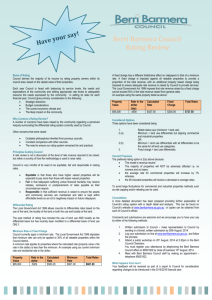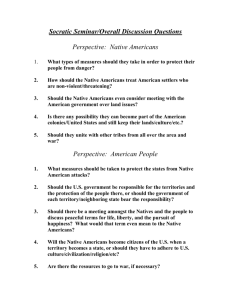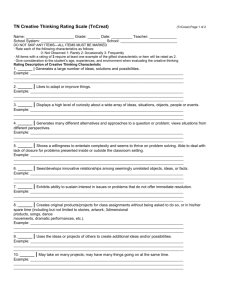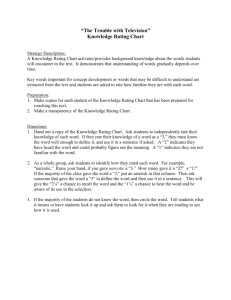Comparison of the Standard Rating Methods and the New General
advertisement
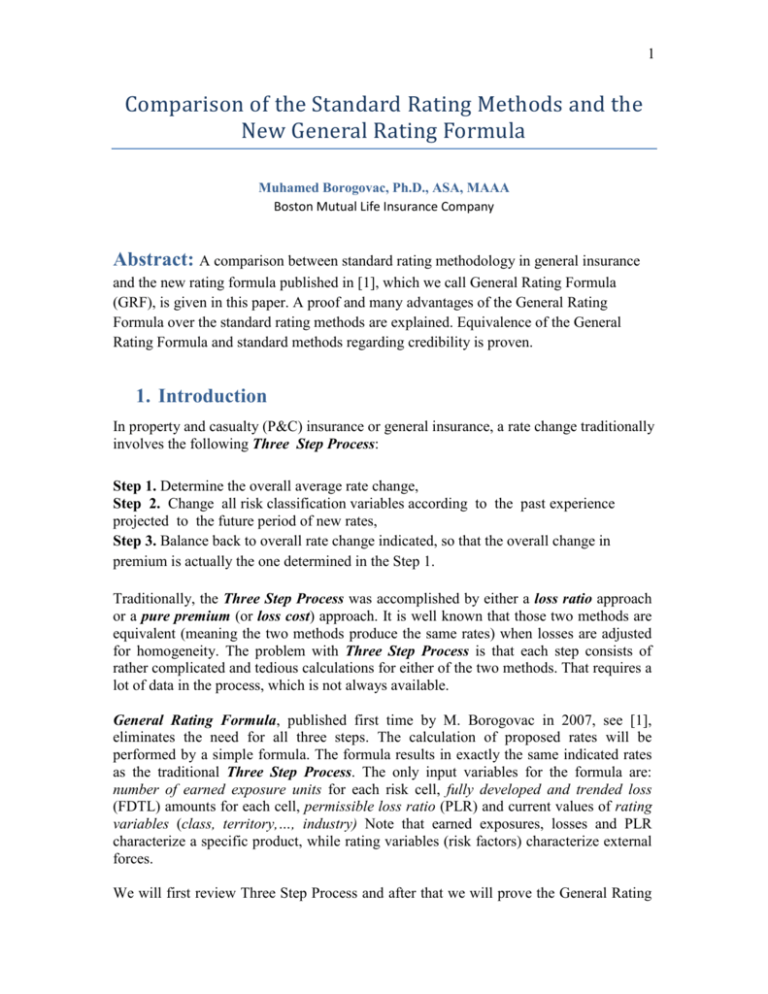
1 Comparison of the Standard Rating Methods and the New General Rating Formula Muhamed Borogovac, Ph.D., ASA, MAAA Boston Mutual Life Insurance Company Abstract: A comparison between standard rating methodology in general insurance and the new rating formula published in [1], which we call General Rating Formula (GRF), is given in this paper. A proof and many advantages of the General Rating Formula over the standard rating methods are explained. Equivalence of the General Rating Formula and standard methods regarding credibility is proven. 1. Introduction In property and casualty (P&C) insurance or general insurance, a rate change traditionally involves the following Three Step Process: Step 1. Determine the overall average rate change, Step 2. Change all risk classification variables according to the past experience projected to the future period of new rates, Step 3. Balance back to overall rate change indicated, so that the overall change in premium is actually the one determined in the Step 1. Traditionally, the Three Step Process was accomplished by either a loss ratio approach or a pure premium (or loss cost) approach. It is well known that those two methods are equivalent (meaning the two methods produce the same rates) when losses are adjusted for homogeneity. The problem with Three Step Process is that each step consists of rather complicated and tedious calculations for either of the two methods. That requires a lot of data in the process, which is not always available. General Rating Formula, published first time by M. Borogovac in 2007, see [1], eliminates the need for all three steps. The calculation of proposed rates will be performed by a simple formula. The formula results in exactly the same indicated rates as the traditional Three Step Process. The only input variables for the formula are: number of earned exposure units for each risk cell, fully developed and trended loss (FDTL) amounts for each cell, permissible loss ratio (PLR) and current values of rating variables (class, territory,…, industry) Note that earned exposures, losses and PLR characterize a specific product, while rating variables (risk factors) characterize external forces. We will first review Three Step Process and after that we will prove the General Rating 2 Formula. The General Rating Formula can be used, not only for rerating of an existing product, but also to calculate rates for a new product. It is understandable intuitively because both, new rates and changed rates will be in effect for a future period. The only difference is that for a new product we have to assume values of input variables, exposures and losses for every risk cell, and risk factor while for rerating, the historic experience of the input variables should be available to us. That is the reason that we can use both names “General Rating” and “General Rerating” formula. 2. Notation and Introduction of the Rating Variables In the calculations that follow, rate classification variables are assumed to be applied multiplicatively. In order to simplify derivation, let us limit ourselves to only three risk classification variables (or factors, relativities, differentials): class, territory and industry. Class, territory and industry are generic risk classification variables introduced only to ease communication and are not examples of any particular P&C insurance product nor a group insurance product. We could not use less than three classification variables for the preceding derivation of the General Rerating formula because that would result in a loss of generality. In that case, it would not be clear how formulae derived for two variables would extend to three or more variables. Let denote the tensor (i.e. three‐dimensional array) of fully developed and trended losses (FDTL). L is also called expected dollar losses (in effective period) or projected losses. We obtain element in the cell by multiplying the current loss of that cell by the development factor and the trend factor. Less formally, we can say is a projected loss in the , , and , where , and are numbers of risk factors for class, territory and industry, respectively. Let us denote the Total Projected (or Expected) Loss by , i. e. (2.1) By keeping fixed one index at a time and by summing loss costs of the corresponding slice, we get: Vector of Loss Costs for Class, , Vector of Loss Costs for Territory, is defined by: , is defined by 3 , , Vector of Loss Costs for Industry , is defined by: . Note on generalization: If we have N>3 classification parameters class, territory, …, industry, i.e. if industry is Nth rather than third classification parameter, then the above formula for Class i would be , , meaning that only summation by index would be omitted. All other formulae would be generalized accordingly. Also, let us introduce: Tensor , where is the Number of Earned Exposure Units in C lass , Territory , and Industry . Let us denote the Total Number of Earned Exposure Units by , i.e. . Tensor , where (2.2) represents Current Manual Rate in the cells . As before, by summing Numbers of Earned Exposure units of a particular slice, we get the following: Vector of Earned Exposure Units for Class, , , Vector of Earned Exposure Units for Territory, , is defined by , Vector of Earned Exposure Units for Industry , is defined by: is defined by: . Earned Premium at Current rates is denoted by . Therefore: 4 . (2.3) Then Current Average Rate, denoted by , is: . (2.4) By summing premium of a particular slice, we get the following: Vector of Premiums for Class, , is defined by: , , Vector of Premiums for Territory, , is defined by , Vector of Premiums for Industry , is defined by: . The, Loss Ratios of the corresponding slices are: , . , . , . In this setting we will deal with two sets of differentials. Let the vectors represent current class, territory and industry differentials, respectively, and let vectors represent new (indicated, proposed) class, territory and industry differentials, respectively. Let us call the cell the base cell. That cell is usually the cell with the largest amount of exposure for the line of business observed so that it has maximal statistical credibility. Without loss of generality, we can denote . This means, 5 we set . We already mentioned that classification variables are applied multiplicatively. Therefore, rate in the cell is defined by: (2.5) From (2.5), it follows . , . 3. Review of the Standard Three-Steps Rating Process 3.1 Overall rate change If denotes new average rate and change (RC) is defined as denotes old average rate, then the average rate , or equivalently, . (3.1) In addition, let us introduce: . Symbolically, . (3.2) Both, loss cost (or pure premium) method and loss ratio method historically were used to calculate the overall rate change. In both, we will need Permissible Loss Ratio, PLR, which is defined as 3.1.1 Loss Cost Method In this method, we first calculate: , (3.3) 6 where and are given by formulae (2.1) and (2.2), respectively. Then, according to this method, the new average rate, denoted by will be calculated as: . Substituting form (3.3) gives: (3.4) 3.1.2 Loss Ratio Method In Loss Ratio method, we first calculate Expected Loss Ratio, defined by (3.2). Then rate change ( ) is calculated as: . Symbolically, . Substituting from here into (3.1) we get (3.5). It is well established that loss cost method and loss ratio method are equivalent for overall rate change, Step 1. In our notation it means that formulae (3.4) and (3.5) are equivalent. 3.2 Changing Risk Classification Differentials In traditional Three-Step Process it is necessary to determine new risk classification differentials. In loss ratio method, the indicated differentials are calculated as: , , (3.6C) 7 , , , (3,6T) , (3,6I) while, in the loss cost method new class differentials are defined by: , , (3.7C) , , (3,7T) , . (3,7I) We saw that loss ratio and loss cost methods are equivalent regarding the overall rate change calculations. It would be convenient if that were the case here as well. Unfortunately, the two methods do not calculate equal indicated differentials if the process is not adjusted for heterogeneity, as the following example shows. Example 3.1 Determine indicated differentials for Class B and Class C, using both methods, given the following information and assuming full credibility of all classes, see [2]. Class Existing Differential ( ) Loss Cost ( A( ) 1.00 0.65 129 B( ) 0.85 0.71 120 C( ) 1.21 0.66 157 Solution: In our notation: Loss Ratio method i.e. formulae , and give: ) 8 , , Loss Cost method i.e. formulae , . , give: and , . /// Note that the results of the two methods are not equal. 4. Adjusting for Heterogeneity and Balancing Back 4.1 Understanding Heterogeneity The uneven distribution of risks by cells is reason that loss cost and loss ratio methods produce different indicated differentials, which means different indicated rates. The uneven distribution of risks is called heterogeneity. In this section, we will introduce variables , , , , , that will be used in the derivation of the formula. First, let us observe the simple example where we have only two classes and only two territories. It will help us to intuitively understand the meaning of the above mentioned variables. Assume that Class 2 consists of risky drivers and that all risky drivers live in Territory 2. In our notation, this means and . The formulae for indicated differentials in Loss Cost method for Class 2 and Territory 2 are, respectively: , . Assume now that everything is the same except for the distribution of risky drivers. Assume that half of risky drivers’ losses belong to those risky drivers who live in the Territory 1. This means that . Then we have , . Hence, the Class differentials did not change (as it should be the case) while Territory 2 differential changed considerably. This means that the risk that comes with territory is affected by the risk that comes with the class, according to this calculation of , and that should not be the case. 9 Let us now look at the Territory 2 differential, in the same example, but by means of the Loss Ratio method. By developing numerator and the denominator, and taking into account we get In this formula, we deal with average loss , which is practically a loss per unit of exposure. Therefore, the distribution of losses by cells does not play a significant role here. Note, that exposures in the denominator corresponding risks adjusted exposure. and are weighted by the . Therefore, we can call the variable total Class 2 4.2. Adjusting for Heterogeneity Now we will apply the lesson that we learned in this example to general situation in order to adjust for heterogeneity the formulae that follow. As every unit of exposure in the cell is expected to cost , we can introduce the following concept, the total Class i adjusted exposure , . Similarly, , ; , . As before, C, T, and I stand for class, territory, and industry, respectfully. The Loss Cost for Class i adjusted for heterogeneity, denoted by , . , becomes: (4.1C) The Loss Cost for Territory j adjusted for heterogeneity, denoted by , becomes: 10 , . (4.1T) The Loss Cost for Industry k adjusted for heterogeneity, denoted by , . , becomes: (4.1I) The base rate for class i (i.e. Class i, Territory 1, Industry 1 rate), denoted by expressed as: , Obviously, . (4.2C) Similarly, (4.2T) (4.2I) Also, the base rates represented by: and for Territory j and Industry k, respectively, can be , ; , . The Fully Developed and Trended Loss Ratio for Class i , denoted by , (Here we used formulae (4.1) and (4.2).) Similarly, , , , . . , is , can be 11 4.3 Indicated Differentials Adjusted for Heterogeneity In Loss Ratio method, after adjustment for heterogeneity we calculate class differentials by , , while, in the loss cost method new class differentials are defined by , . We have , Here we used the previously proven equation . (4.3C) , . Similarly, , , , (4,3T) . (4,3I) The superscripts , , and stand for class, territory, and industry, same as before. The last three equations prove the following classical statement. Corollary 4.1 Loss ratio method and loss cost method are equivalent if loss costs are adjusted for heterogeneity. The big advantage of the General Rating Formula over both standard methods is that we will not have to actually calculate indicated risk classification differentials. Remark 4.2 In the current texts, experience loss ratio is defined as current losses divided by earned premiums. In this text, losses are fully developed and trended. One might think that loss ratios used above are different from the experience loss ratios used in the traditional texts. However, the values of , , are the same because the 12 development and trend factors are applied on both, numerators and denominators. Therefore they cancel out in the above relations for , , ./// 4.4 Balancing Back Obviously, the indicated differentials will be different from the current ones except . However, the rates calculated by means of the indicated differentials in the standard methods may give different rate increase than the desired increase calculated in Step 1. In order to make a correction in the process we multiply those indicated rates by the Balance Back Factor (BBF). As we know, BBF is defined by: . In our notation it reduces to: . Example 4.3 Given: Base rate: Trend*Develop. Factor: Permissible Loss Ratio: Earned Exposures: Class Territory1 Territory2 Class1 12,000 3,000 Class2 4,500 2,000 Current Losses: Class Territory1 Territory2 Class1 840,000 300,000 Class2 500,000 250,000 Class Differentials: Territory Differentials: T 13 Calculate new rates. Solution by Standard Method adjusted for heterogeneity Step 1, Overall Rate Change: Multiplying Current Losses by the Trend*Development Factor = 1.409 we get array (matrix) of Fully Developed and Trended Losses. Then, Total FDTL is the sum Let us first calculate . . According to (2.3) we have: According to (3.5) we have the average rate increase: Step 2, Calculation of Indicated Differentials In order to calculate indicated differentials adjusted for heterogeneity we first have to calculate: . . According to equations (4.1), simplified to two rating variables, we have: 14 Therefore: Indicated class differentials: Indicated territory differentials: , , Step 3, Balance Back Factor Finally we can calculate the indicated rates: /// 5. General Rating Formula 5.1 Derivation of the Formula In the previous sections we introduced notation, terminology and equations that will enable us to finish the derivation of the General Rating Formula. Recall, that the goal is to find easier way to calculate same rates that are calculated in the standard Three-Step Process. . Symbolically 15 . The overall rate change is equal to: , (5.1) where PLR stands for Permissible Loss Ratio which is sometimes called Expected or Target Loss Ratio. Let us denote the indicated rates by . Then, form (5.1) it follows: . Let us substitute expressions for and . According (2.3) and (2.5) . Hence, after canceling , Substituting from formulae (4.3) we get After canceling out constant we get the final formula (5.2) 16 Note that the number (5.3) in the denominator is a constant number for all cells it only once and then we calculate rates by the formulae . . It means that we calculate (5.4) This is the General Rerating Formula that calculates exactly the same rates as standard Three-Step Process. The advantages of the General Rerating Formula over the traditional, Three Step Process is the following: 1. We only need to know losses and earned exposures for every cell, and current differentials. 2. We do not even need to know current rates. 3. We do not need to calculate overall rate change. 4. We do not need to calculate indicated differentials. 5. We do not need to calculate balancing back factor. 6. The rates calculated by the General Rerating Formula are already adjusted for heterogeneity. 7. If we want, we can calculate (uniquely determined) indicated differentials, by simple formulae. Remark About Generalization: In general case, when there are N>3 classification parameters class, territory, …, industry, i.e. industry is Nth rather than third classification parameter, then General Rating Formula is . (5.5) As before, the formula can be written equivalently as: ; , to underline that the denominator is a constant for all cells calculated only once. , and therefore 17 General Rerating Formula for two rating variables: Assume that we have a product with two classification parameters Class and Territory. Then the General Rerating Formula simplifies to , . where Example 5.1 Assume given all information as in the Example 4.3, except base rate which is not needed in for General Rating Formula. Hence, Trend*Develop. Factor: Permissible Loss Ratio: Earned Exposures: Class Territory1 Territory2 Class1 12,000 3,000 Class2 4,500 2,000 Current Losses: Class Territory1 Territory2 Class1 840,000 300,000 Class2 500,000 250,000 Class Differentials: Territory Differentials: T Calculate new rates. Solution by General Rating Formula: Multiplying Current Losses by the Trend*Development Factor = 1.409 we get and We need to find . , nd . and then and , 18 . Now we have, according to equations (4.1), when simplified to two rating variables and round: Now we calculate the denominator constant variables: given by formula (5.3) adjusted to two . Now we have all that we need to substitute into General Rating Formula (5.4) for two rating variables and calculate indicated rates: ; ; ; . The rates are the same as the rates obtained by standard method, except for small rounding errors. (Corresponding excel calculations produce identical rates.) 19 Note that adjustment for heterogeneity is built in the GRF calculations. Also note that this calculation has all the advantages listed earlier in the section General Rerating Formula, including the fact that we did not need to calculate indicated differentials. However, if we need to know indicated differentials, they are given by formulae (4.3), and they are already adjusted for heterogeneity, therefore uniquely determined. Let us calculate them here: Indicated class differentials: , Indicated territory differentials: , /// 5.2 Credibility of the New Rating Method Credibility is not uniquely determined concept. There are different formulae, and even in the same formula there are different definitions for the full credibility. For example, full credibility is assigned to different numbers of exposures, sometimes depending on the judgment of the actuary. The following section is the quote from [2] and describes how credibility was introduced in the standard models. “In practice, the actuary will usually do two separate average rate calculations. One is based on data from the actuary’s own company; the other is based on industry wide data which are normally available from one or more rating bureaus and/or statistical agents. Unless the actuary’s company is very large, the indication based on its data will have credibility Z<1. Then the final answer will be Credibility-Weighted Average Indicated Rate=Z*(Company Indication)+(1-Z)*(Industry Indication).” In this section, we will describe how to adjust for credibility in the new method characterized with the General Rerating Formula (5.3). Credibility factor always depends only on company’s data and we will determine it the same way as before by selecting one of the standard credibility formulas. Using industry experience to make corrections on company’s rates makes sense only if we deal with the same products. That means that our product and industry products observed, theoretically have the same cells, or otherwise we would be mixing apples and oranges. In practice, this means that sometimes we will have to adjust industry’s cells to company’s usually by combining similar cells. For example, if industry data has three rating variables, Class, Territory, and Industry, and company’s product have only two, 20 Class and Territory, then exposure in the cell should be same token we would adjust and all other industry data. . By the Then, in order to be consistent with the above quoted standard approach to credibility, we will do two separate rate calculations by means of the formula (5.3). Therefore, we will get two rates for each cell, the company’s, and the industry’s rate. Let us prove that two approaches remain equivalent after the credibility. Theorem 5.2 Standard Three Step Process and General Rating Formula produce the same future premiums if rates are adjusted for credibility by the same factor Z. Proof: Let us denote the future earned exposures by company rate by . Let us denote industry rates by , company rates by and average and average industry rate by . Then, the rate adjusted for credibility, according to General Rerating Formula approach, in every cell equals (5.6) Obviously and . That means (5.7) (5.8) Premium adjusted for credibility, calculated by means standard methods, is Premium adjusted for credibility, calculated by General rating Formula approach Substituting into the last equations expressions from (5.7) and (5.8) we get is 21 We have proven the statement. /// References [1] M. Borogovac, General Re-rating Formula, SOA Monographs, 2007 Enterprise Risk Management Symposium. [2] R. L. Brown & L. R. Gottlieb, Introduction to Ratemaking and Loss Reserving for Property and Casualty Insurance, Second Edition, ACTEX Publications, Inc., Winsted, Connecticut [3] R. L. Brown, On the Equivalence of the Loss Ratio and Pure Premium Methods of Determining Property and Casualty Rating Relativities, Journal of Actuarial Practice, Vol. 1, NO 2, 1995
